When we think of Strawberries, there are many happy thoughts that come to mind. Desserts and ice-cream, jams and sauces, or just the pure joy of eating them as is out of a bowl. There is something about this delicious fruit that takes me straight back to childhood.
If you don’t already have the joy of growing your own strawberries, our guide can help to get you started. We’ve got advice about how to produce your own strawberries in the garden and in pots, how to care for them, and pests and diseases that you might be competing with.
More...
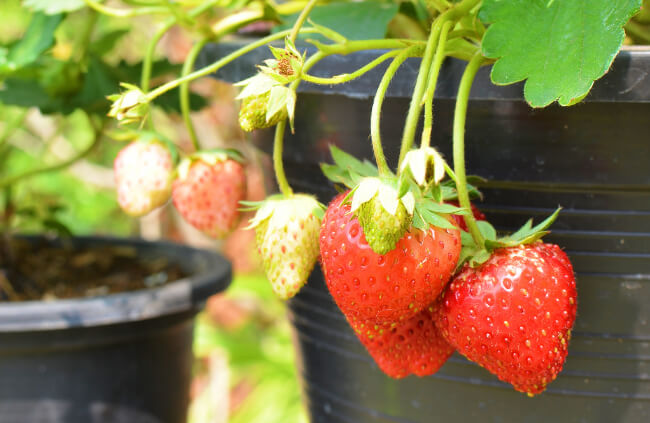
Family: | Rosaceae |
|---|---|
Genus: | Fragaria |
Common Names: | Strawberry |
Origin: | France |
Location: | Outdoor |
Type: | Flowering plant |
Growth: | Up to 20 cm tall and 30 cm wide |
Sun requirements: | Full sun |
Foliage Colour: | Green |
Flower Colour: | Pink, red, white |
Flowering: | Varies |
Fruit: | Varies in size, intensity of flavour, sweetness and acidity |
Maintenance level: | Moderate |
Poisonous for pets: | No |
Growing Strawberries in Australia
When it comes to planting and harvesting strawberries, it all depends on the climate. In warmer climates, you should plant strawberries from March or the start of autumn, and for colder climates, you can plant at the end of winter in August. Harvesting the strawberries can then be done between October and April, so the middle of spring to autumn.
There are different types of strawberry – they can either be summer-bearing or everbearing. The summer-bearing kind produce big fruit and have one harvest that lasts about 2 weeks during summer.
The everbearing strawberries produce fruit during the warmer months. The amount of fruit produced is smaller and more spread out over time.
Popular Strawberry Varieties
Alpine Strawberry

Alpine strawberries are smaller overall than the modern strawberries we know. They don’t have any runners and the fruit is quite small. They also bear fruit throughout the growing season.
Strawberry Big Sweetie
This variety is very popular and produces big fruit that is cone shaped, with a bright red colour and glossy look. The strawberries are juicy and have little acidity. It likes plenty of fertiliser and produces white flowers.
Chandler Strawberry
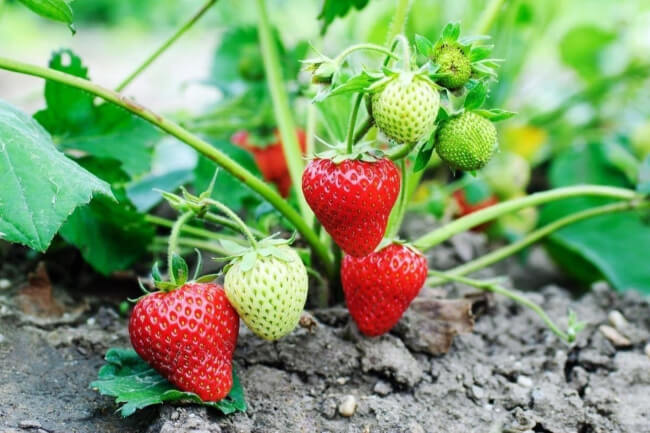
Source: Strawberry Plants
This variety supposedly has the best flavour when it comes to the larger strawberries. It produces plenty of large fruit and has some tolerance to frost. This variety originates from California.
Strawberry Delight

Source: Primrose
This variety looks great in a hanging basket, growing abundantly and producing fruit throughout the growing season. It produces pink flowers and a medium sized strawberry which is heart shaped with a deep red colour and is lovely and sweet. It grows easily and is hardy.
Delizz Strawberry
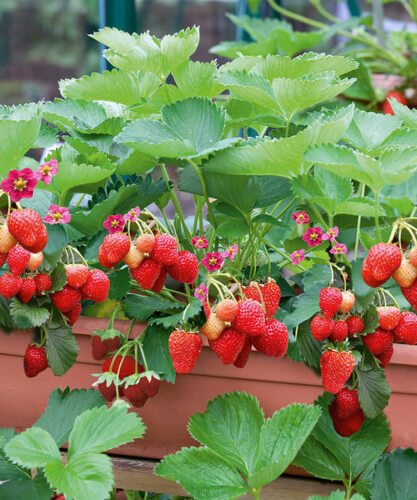
This strawberry plant is more compact with stems that grow upright, with white flowers. The strawberries are a medium size and have a lovely fragrance. There are 2 crops that the plant produces which happen at the end of spring or start of summer, and also in autumn.
Strawberry Juliette
The fruit is big, glossy, sweet and juicy. This particular variety has been created to be more resistant to local pests and diseases. It grows well and produces fruit usually in September, or a little later in a warmer climate.
Strawberry Lowanna
This strawberry variety has been bred specifically for Australia’s growing conditions. The strawberries produced are plentiful, big and shaped like a cone in a bright red colour.
The strawberries are glossy, sweet and juicy. They will grow well in a pot or hanging basket.
Strawberry Red Gauntlet

Source: White House Nursery
This everbearing variety originated in Scotland. It produces lots of fruit and does well in colder weather. This variety is great for making jams.
Strawberry Red Rose
This variety will do well in a hanging basket. It produces lovely pink to red flowers and medium sized strawberries. It will do well with a fertiliser rich in potassium.
Strawberry Ruby Ann
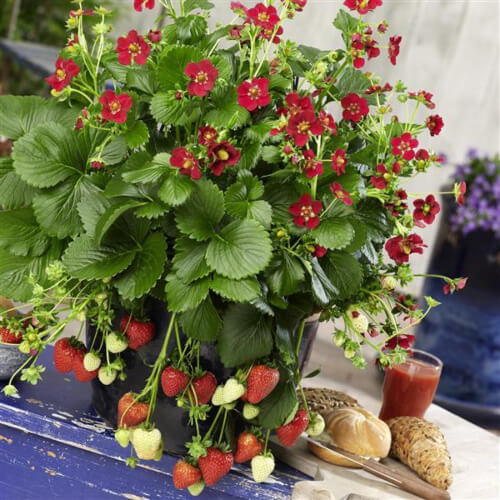
Source: Ball Seed
As the name suggests, the plant has ruby red flowers with a gold centre and produces juicy strawberries. It’s an everbearing variety and grows quite compactly if you’re looking for a variety to grow in a pot. Its runners don’t spread out, making it perfect for container planting.
Strawberry Supreme
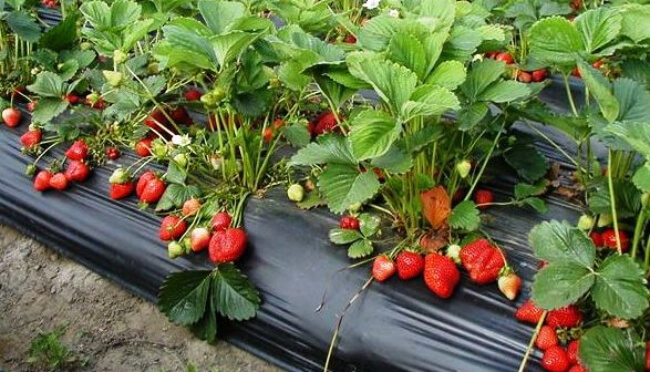
Source: Green Garden Nutrients
This everbearing variety provides a very long season for harvesting the strawberries and the fruit grows above the leaves. The fruit is medium sized and looks like your classic red strawberry. The flavour is sweet and great for making jam.
Strawberry Sweetheart

Source: Gardeners Dream
This variety comes from the UK. The strawberry plant grows generously and produces small sweet fruit. The flavour is rich and best enjoyed eaten fresh.
Strawberry Temptation
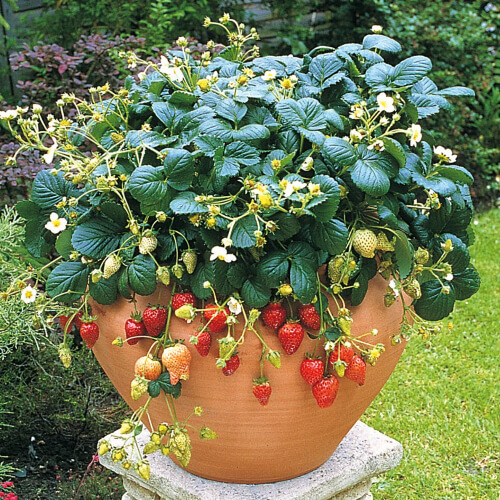
Source: The Diggers Club
Also an everbearing variety that does well in pots, producing sweet fruit that is medium to large. These plants don’t produce runners. This variety produces most of its fruit in autumn.
Strawberry Tioga
This variety produces big strawberries during spring and summer. They are delightfully sweet with low acidity. Strawberry Tioga originated in California and does well in Australia.
Toolangi Choice Strawberry
Toolangi Choice is a type of Californian strawberry. The plant produces plenty of bright red fruit with great flavour. You can expect a generous harvest of fruit in spring and summer.
You might have heard of Irish Strawberry Trees and wonder why its not included in this list, well, because its not a true strawberry of the genus Fragaria.
Growing Strawberries in the Garden
When you prepare the garden site for planting your strawberries, we recommend adding a layer of compost as well as bone meal and organic fertiliser. Strawberries like a soil that is slightly acidic with a pH of 5.5 to 6.8.
When doing your planting, space your strawberry plants 30 cm apart which allows enough space for their runners to spread out. Also be sure to choose a site that gets enough sun, as the strawberries need up to 8 hours of sun per day.
Bury the roots of each plant well when planting so that the crowns are just on top of the soil. Add mulch and then give the plants a good watering session. You’ll be sure to get an abundance of fruit if you use a continuous-release fertiliser.
When the strawberries are ready to harvest, you can do this early in the morning and be sure to pop them in the fridge straight away. It’s recommended that every 3 years you transplant your strawberries into fresh garden beds.
How to Grow Strawberries in Pots

Ideally, each strawberry plant needs a pot that is about 20 cm in diameter and 15 cm deep. Strawberry plants don’t like to feel cramped. Fill your chosen pot with a potting mixture that is loose and loamy.
This combination means that the soil can hold water, but also drain off any water it doesn’t need. It’s important that your pot has a drainage hole.
When you plant your strawberries, make sure the crowns are just higher than the surface of the soil. You can create a mound in the planting mix, spread the roots over it and then cover them just up to the crown, but not over the crown.
Water the soil well once you’re done planting. The pot needs to be in a place that will get between 8 and 12 hours of sun daily, and for sunlight that is one directional, you can rotate the pot every few days.
Check the soil often and give the plant water if the soil feels dry. Watering twice per week is a good guideline, but let the dryness of the soil guide you to avoid making the soil soggy. Soil in pots dries out quicker than soil in the garden so if the weather is hot and dry, you’ll need to increase watering.
Strawberry plants living in pots will need some extra food and you can feed them once a month using a liquid fertiliser. This is especially important to do during autumn to help the strawberries fruit the following season.
Growing strawberries in pots has the added benefit of being able to manage pests and diseases more easily.
Propagating Strawberries
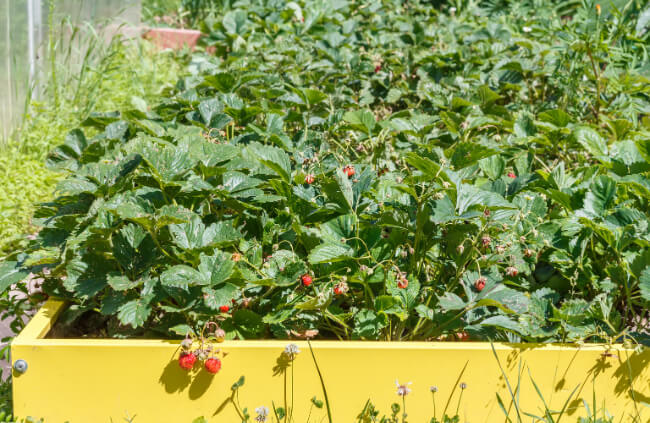
You can easily propagate your own strawberry plant using seeds from an existing strawberry. These are easily accessible and easy to remove as you can just pick them off the skin by scraping them off the fruit. Spring is the best time to sow the seeds.
You can prepare containers or trays filled with a peat mixture. We don’t recommend potting soil. As you sow each seed, you can cover it just slightly with the mixture. It’s important to ensure that the seeds don’t dry out so be sure to maintain moisture levels.
If you are able to keep the tray or container of seeds in a plastic bag, that is even better as it will lock in moisture for the germination process to take place. When you do need to water, it’s a good idea to use a spray bottle so that you don’t end up soaking the mixture.
Within about 3 weeks you should start to see the first signs of growth. You can now take the container out of the plastic bag and at around the 8 week mark, you can prepare to plant your strawberries in the garden or into a pot.
Caring for Strawberries
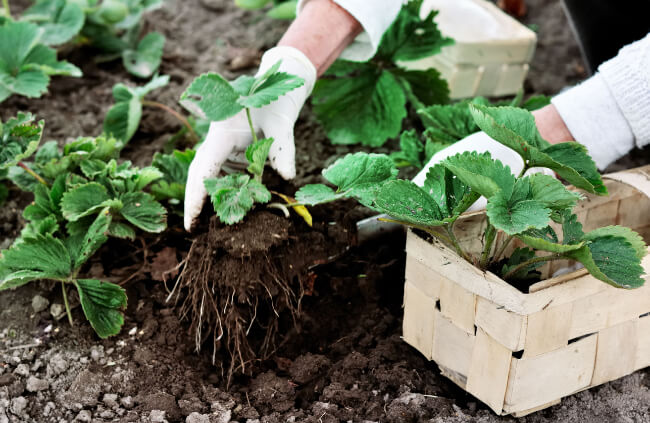
Sunlight
Make sure your strawberry plant gets at least 6 to 8 hours of full sun per day.
What Soil to Use
Strawberries like a soil that is more on the acidic side and it should be well-draining. If you live in an area with more alkaline soil, you could aim to grow your strawberries in a big pot and use a compost rich potting soil.
For heavy clay soil, you could mix in composted leaves and rotten sawdust. We also recommend creating soil mounds that are raised to help with drainage. If you have sandy soil, you can simply add a layer of compost or rotted manure and keep an eye out for any weeds.
Watering Strawberries
Water your strawberries about 2 to 3 times a week and do it in the morning. Try not to get water onto the leaves because it can end up causing fungal diseases. When you start to notice that the fruit is ripening, this is your cue to cut back on the watering. Just ensure that the soil doesn’t ever dry out.

Pruning
For the first two years of the strawberry plant’s life, you can cut off the runners when they appear and the right place to cut is where they join the main plant. By doing this, the plant will use its energy to create flowers and fruit.
By year 3, you can then allow the runners to spread out and develop. During autumn, select the 2 strongest looking runners for each original plant and secure these to the soil to help with root growth.
When you start to see new leaves on the runners, you know that they have managed to create a good root system. You can then transplant the new plants into other parts of the garden or suitable pots as needed.
Fertilising Strawberries
You can fertilise your strawberry plant in autumn and spring using an organic granular fertiliser. Keeping a thick layer of mulch around your plant is also recommended. The use of a controlled release fertiliser is helpful to boost plant growth.
When and How to Harvest Strawberries
Strawberry fruit is usually ready to be harvested between 4 and 6 weeks after it has blossomed. Make sure that you only harvest the berries that are completely red, as this indicates they are ripe.
You can pick your strawberries every 3 days. When you remove them, be sure to cut them off at the stem. If you just pull the fruit off, you could end up damaging your plant.
How to Store Strawberries
If you’re planning to eat your strawberries straight away, it’s best to store them at room temperature. For strawberries that you want to store for later use in cooking, you can pop them into the fridge.
If you store them correctly, they can keep their freshness for up to a week. The strawberries should be kept dry and cold, which can be done by lining a plate with some paper towel and then you put the strawberries on top in a single layer.
Cover them with some plastic wrap and then just keep an eye on the strawberries and check for any that have gone mouldy so they don’t spread to the rest while in storage.
Don’t wash the strawberries before storing them. The extra moisture makes the strawberries go soft and can lead to mould. Rather wash as you go when you use them. Keeping the green stems on fresh strawberries also extends their shelf life and storage time.
For more long term strawberry storage, you can freeze them. Take off the stems and then cut the strawberries into quarters or slices. Place them on a baking sheet and freeze them until they are solid which takes about half an hour. You can then pop the strawberries into a freezer bag and they can then be stored for up to 3 months.
Possible Strawberry Pests and Diseases to Look Out For
Grey Mould
This is a fungus that can easily attack plants that have some damage and spreads really quickly to the healthier parts of the plant. The fungus loves moisture so if your plants are quite wet, they are at a higher risk for infection.
Often the first sign of this disease is spots that look like water marks on the leaves and sometimes, they are white in colour. The spots change colour, grey or brown, and can end up covering most of the leaf.
The leaves will start to wilt. If you live somewhere with high humidity, you might also notice a type of grey web on the leaves, which contains spores. Other parts of the plant can be affected too.
You’ll need to get rid of the entire plant and then apply a suitable treatment spray between the plants so that the disease doesn’t spread to other parts of the garden. The spray can also help to prevent future infections.
Powdery Mildew
This fungus creates a layer of mildew on the plant's leaves which contains plenty of spores. These spores can then be transferred to other plants by wind for example. This disease can slow down your plant growth and can also affect how many strawberries are produced and the quality of the fruit.
Powdery mildew likes warm and dry weather but also needs some humidity around the plant itself in order to spread. In areas that are cooler and have lots of rain, the spread of this disease is more contained, as well as areas with high temperatures.
Your strawberry plant might look like it is covered in flour and the round white spots can end up on the leaves, stems and even the fruit. It often grows on the underneath side of the leaves too. Younger plants are more at risk and in this case, the leaves become yellow and dry. Leaves might also look twisted or damaged.
Planting your strawberries in a sunny place helps, as powdery mildew favours shade. Pruning promotes good air circulation and keeps humidity levels down. You can treat the disease using an organic fungicide that contains sulphur, neem oil or potassium bicarbonate.
Baking soda is another easy solution. You can mix 1 teaspoon of baking soda with 1 litre of water to make up a spray. You’ll need to spray the plants well and make sure they are covered entirely when you spray.
Japanese Beetles
Japanese beetles are just over a cm in size and have bright blue or green heads. They enjoy eating leaf tissues and the leaves look like they only have veins left. Since the beetles are easily spotted, you can pick them off by hand.
Alternatively, you can spray your plants with neem oil or a spray that has potassium bicarbonate. The beetles pass on a chemical from the neem oil to their eggs and this inhibits the larvae by killing them off.
Slugs and Snails
These pests like to lay their eggs in wet soil or compost and they love cool and moist environments. It helps to water your plant in the morning so the soil can dry out before night hits and the slugs and snails head out to feast.
Planting mint can help to keep damage to a minimum. You can create traps for these pests using things like citrus skins as the slugs and snails will retreat into these hiding places for shade.
You can lay down egg shells close to your strawberry plants which deters the pests as well.
What We Learned While Growing Our Own Strawberries
- Insects love them. Especially the two-legged variety who fight over the TV Channel and dirty the bathroom. Aphids and Slater beetles are also particularly notorious and while most advise using some sort of chemical repellent or spraying your fruit, I’ve found that by keeping them up off the ground in a container or hanging pot can almost halt most infestations.
- Keeping strawberries from coming in contact with the soil has the added bonus that they’re given more space for airflow. This way they ripen more evenly.
- After 2-3 years strawberry plants slow down in production so it’s time to start again with some new runners. Accept this as a positive option to try some new varieties.
- Allowing too many runners to be produced is bordering on ‘evil’. Firstly, it means that the strawberry plant is putting all its energy into producing these rather than yielding fruit. Second, if too many runners are allowed to grow in the same bed it restricts the availability of nutrients and crowds the plants ability to grow.
- If you have to grow them in the ground, mound the soil and cover with some gauze matting. Don’t use black plastic unless you live in a cold climate and you want the soil to heat up otherwise it will become unbearable for your strawberries and they will struggle.
- When planting strawberries, always leave the crown just above the surface otherwise the plant will rot.
Finding a variety that will grow in your garden is as easy as finding a neighbour who is keen to let you dig up a young runner. There are also usually a few varieties available from a nursery at the start of spring.
Frequently Asked Questions About Strawberries
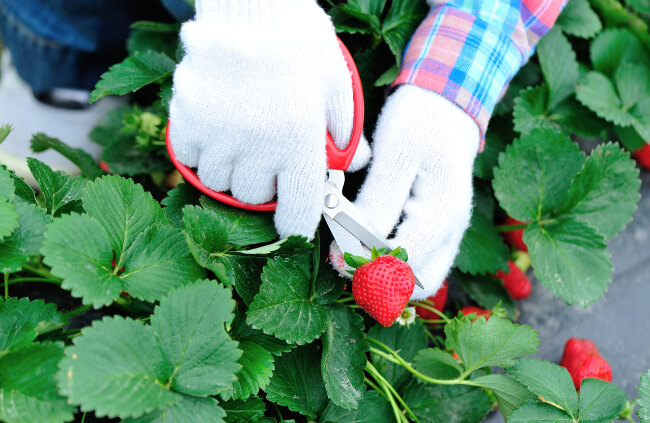
What is the best way to harvest strawberries?
Ideally the fruit should be picked in the morning when it’s still cold and then put straight into the fridge. They can be rinsed well just before eating. Only harvest the fully red strawberries and you can pick fruit every 3 days.
Cut the fruit at the stem instead of pulling it as you might cause damage to the plant.
How long can you store strawberries for?
You are able to store strawberries that haven’t been washed in the fridge for up to 5 days. They can also be frozen for up to 2 months.
Which country produces the most strawberries worldwide?
China produces 36% of the total strawberry production globally and cultivates over an area of 125,637 hectares.
Where would you find the best strawberries in the world?
This would probably be Amaou strawberries from Japan where it is known as the King of Strawberries. They are much loved in Japan but are also exported to Hong Kong and Taiwan as a luxury item.
What is the oldest strawberry variety in the world?
The Royal Sovereign is a strawberry variety that originated in England in 1892. The species is Fragaria x ananassa and it is still cultivated today.
Where did strawberries originate?
The garden strawberry as we know it, was first created in Brittany, France in the 1750s. It was a cross between a Fragaria virginiana from eastern North America and a Fragaria chiloensis from Chile.
Get inspired by other plant profiles and gardening tips. Sign up for our newsletter.
Have Fun Growing and Harvesting Your Own Delicious Strawberries
I couldn’t imagine anything better than having my own strawberry plant in the garden and being able to harvest delicious fruit for my breakfast, or to whip up a dessert when people are coming over.
They are super easy to propagate and create new plants, and I haven’t met anyone yet who doesn’t enjoy a bowl of fresh strawberries. Strawberries will no doubt bring health and happiness to your garden (and your life).
Published on June 6, 2023 by Maisie Blevins
Last Updated on February 23, 2024




